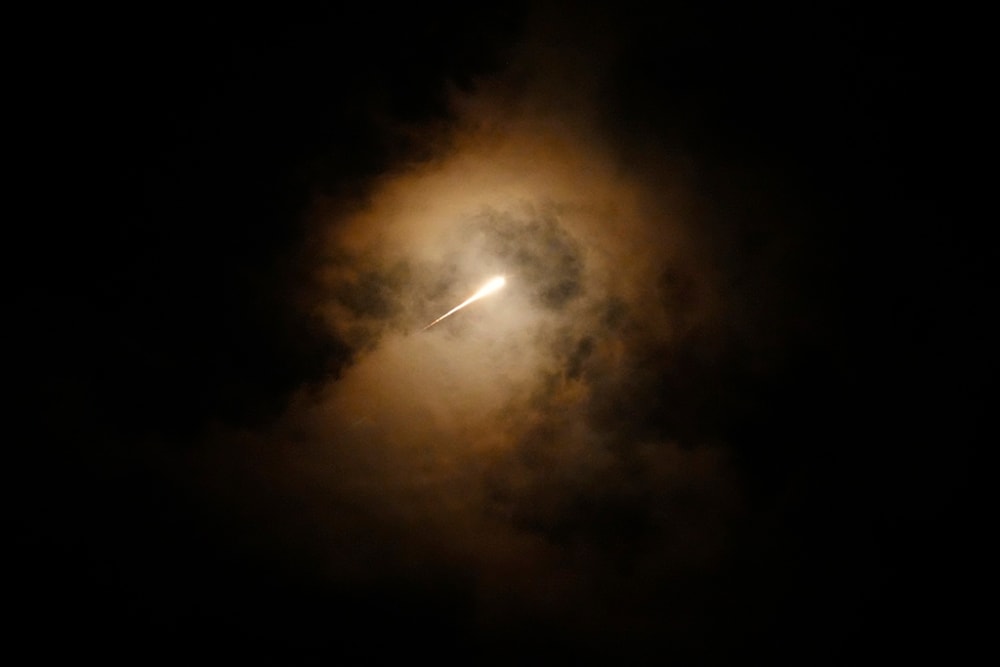Iran's success triggers concerns of joint Resistance op: The Guardian
A piece published by The Guardian confirms the success of Operation True Promise 2, highlighting the concerns among "Israel" and allies regarding the implications of a greater, joint operation by the Axis of Resistance.
-

Projectiles fly through the sky in central 'Israel' as a siren sounds a warning of incoming missiles fired from Iran towards 'Israel', Tuesday, Oct. 1, 2024. (AP)
Iran's missile attack against occupied territories on Tuesday night prompted security concerns in "Israel" and among its allies over the consequences of a potential joint operation led by the Axis of Resistance, including Iran and the Islamic Resistance in Lebanon - Hezbollah, a piece published by The Guardian said.
In the article, Peter Beaumont says that while footage circulated showed massive fires at the military bases, particularly Tel Nof Airbase, "Israel" and its allies rushed to coin the attack a failure. However, Beaumont argues that the understanding of the Iranian attack does not solely depend on the damages that were inflicted, but rather on the fact that 181 missiles were able to bypass and pierce the "mighty" Israeli interceptors and air defenses.
According to the author, Iran's operation was able to achieve exactly what it set out to, triggering long-running concerns regarding "Israel's" security and the implications of a possible joint missile attack by the Axis of Resistance.
What is worth noting, however, is the precision that was showcased during the attack, marked by barely any damage to civilian infrastructure, other than minor ones inflicted by shrapnel dropping post-interception.
Although "Israel" boasts its interception and aerial defense capabilities, it also prepped healthcare centers and hospitals to anticipate and expect mass casualty events for when a scenario like Iran's operation plays out.
Commenting on the attack, "Israel's" Haaretz daily reported that the occupation forces refused to announce the percentage of interception on Tuesday night to allegedly prevent Iran and Hezbollah from obtaining key information that would "help them learn lessons." This, according to Beaumont, confirms what reporters and analysts deduced from the attack: Despite Israeli allegations of almost impeccable interception, the Iranian missiles in both waves penetrated occupied airspace and reached their targets.
The Fruit of True Promise 2
In other attempts to justify the penetration, Israeli military officials claimed that Iran used its "most advanced" missiles to carry out its operation.
In this context, Iran's IRIB news agency reported that the IRGC used the Fattah hypersonic missile in its attack and reportedly pierced the Israeli anti-missile shield, which consists of Arrow-2 and Arrow-3 anti-ballistic missiles.
The IRGC announced that three military bases were successfully targeted: Nevatim, Hatzerim, and the Tel Nof Airbase in Tel Aviv.
In detail, the Nevatim base houses the F-35 fighter jets, and the Hatzerim base houses the F-15 fighter jets used to assassinate Martyr Sayyed Hassan Nasrallah. The IRGC affirmed that the latter was targeted in response to the assassination of Hezbollah's martyred leader.
Additionally, at least 90% of Iran's ballistic missiles and projectiles launched from its first wave toward occupied Palestinian territories struck their targets, according to the IRGC's second statement released post-response.
#Iran carried out Operation True Promise 2, the Islamic Republic's unprecedented attack on "Israel" in retaliation against the Israeli assassinations of Ismail Haniyeh, Sayyed Hassan Nasrallah, and Nilforoushan.
— Al Mayadeen English (@MayadeenEnglish) October 2, 2024
Hundreds of ballistic missiles rained down on Israeli bases while… pic.twitter.com/rbMGPCWBf6

 3 Min Read
3 Min Read








